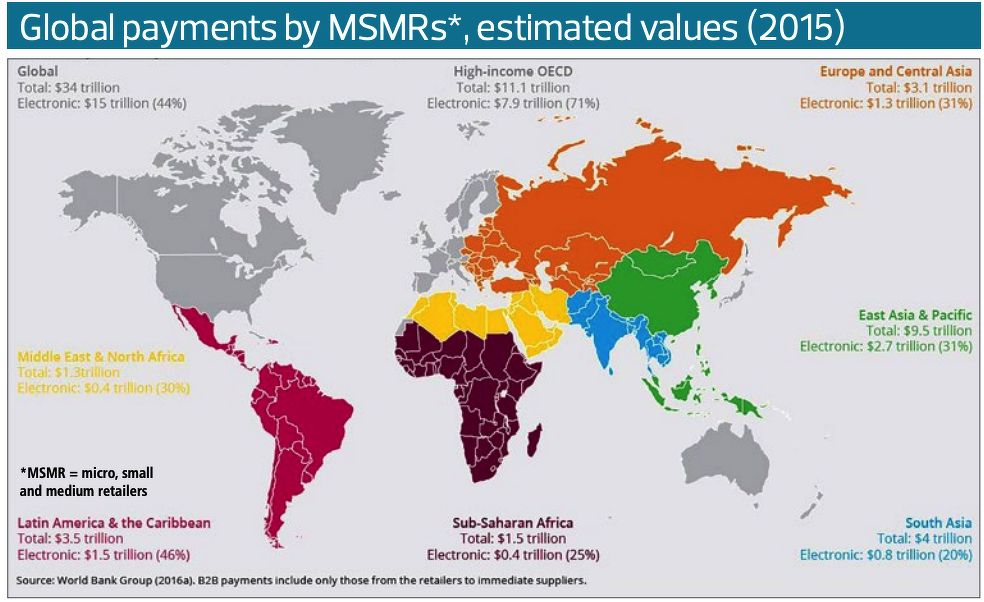Banks have been unwilling to take the higher credit risk and higher cost of accessing these customers. Disruptive businesses in tech or telcos have used mobile technology to drive more innovative client acquisition and product offerings, targeting this harder to reach segment with fewer issues around “trust” of financial institutions.
The traditional model
The traditional model of micro-lending, based on the provision of small cash loans to community groups to support working capital needs, was initially developed in Bangladesh in the 1970s. This has expanded geographically and evolved over time so that today’s micro-lenders operate in markets as diverse as Indonesia, Mexico and sub-Saharan Africa and offer a range of loans, savings and entry-level insurance products. The group-lending model is a tried and tested way of harnessing both development capital and public markets to generate attractive returns and positive impact. Micro-lenders like ASA International operating in frontier markets, Gentera in Mexico and Bandhan Bank in India have been a source of attractive risk-adjusted returns and high growth, outside of market shocks during the GFC and the global pandemic. As we see the impact of Covid-19 through rising unemployment rates and a resurgence of informal markets, these lending models will continue to provide an important re-entry point to the formal market, supporting recovery.
Growing the opportunity set
In the last decade, there has been a technologically-driven positive shift in terms of access to finance. The expansion of mobile phone infrastructure has seen the development of new business models to support micro-enterprises and individuals. In 2007, Vodafone, in partnership with its subsidiary Safaricom in Kenya, seized the commercial opportunity to drive mobile transactional banking through its M-Pesa platform. Like the traditional group-lending model, product innovation now means that a range of insurance and banking products are available, in addition to peer-to-peer and individual-to-business transactions. Investors who were able to identify this opportunity early would have generated a total return in US dollar terms of 521% against the MSCI Emerging Market Index return of 33% over the last 10 years.
The technological shift continues with mobile money and e-wallets leap-frogging traditional banking in many markets across Latin America and Asia, creating a wealth of investment opportunities. In turn, this has forced banks across our investment universe to invest faster in digital innovation and product offerings to both retail clients and SMEs. This process has been accelerated by the pandemic with many banks in Emerging Markets reporting a faster pace of adoption of mobile banking services both on the part of clients and the banks themselves. In Mexico, for example, clients historically needed to present their documents in a branch to finalise account opening, whereas local bank Banorte rolled out a fully digital process for client on-boarding.
Looking forward
The United Nations highlights the importance of SMEs in achieving progress towards the 17 UN Sustainable Development Goals (UNSDGs) which serve to identify the greatest challenges and opportunities facing the world today. Working with the International Council for Small Businesses, the UN has identified that micro-enterprises and SMEs “make up 90% of all businesses globally and account on average for 60–70% of total employment and 50% of GDP.” Facilitating the profitable growth of SMEs can target SDG 8 — “Decent Work and Economic Growth” and SDG 9 — “Industry, Innovation and Infrastructure”. However, it is clear that availability of SME financing remains poor. In Mexico, SME lending accounted for only 20% of business loans in 2016, behind regional peer Brazil and many OECD countries. This represents a huge opportunity for all investors, not only those who are looking to allocate capital in alignment with the UNSDGs.
Following the success of mobile money, mobile operators and fintech businesses are turning to SMEs that represent another poorly-tapped pool for financial inclusion. As an engine for future growth, Safaricom has developed a product for merchants leveraging the M-Pesa platform LipaNa, which grew revenues by at least 30% in 2018. The pool of opportunities is exciting and continues to develop, from e-wallet providers to digital point-ofsale devices offering working capital lending. World Bank data showed that small businesses in OECD countries transacted electronically 71% of the time, however, the global figure is only 44%, illustrating the significant runway for growth in emerging economies.
Pandemic a setback but opportunity for growth remains compelling
If you broaden the definition of financial inclusion to businesses driving greater profitability and improved routes to market such as cloud providers enabling faster digitalisation and software companies offering ERP solutions, you open the door to exciting and profitable investments, such as Douzone Bizon in Korea or Kingdee International in China, have delivered total returns of 239% and 342% respectively over the last three years
Prior to the emergence of Covid-19, the World Bank estimated that the global unbanked population would fall to 10% by 2022 and there are clear opportunities for expansion of SME financial inclusion. The economic setback will likely delay this process but the opportunity for growth and development of innovative business models remains compelling. Identifying these businesses allows investors the opportunity to benefit from attractive relative returns as well as aligning themselves to the UN’s development goals and achieving positive social change.
Fiona Manning is investment director, global Emerging Market equities, Aberdeen Standard Investments







